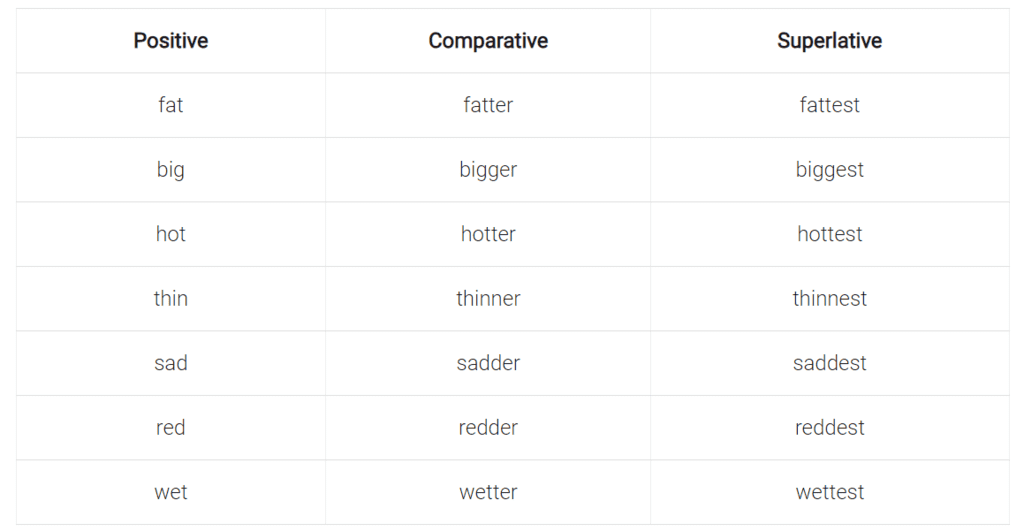Degrees of Comparison | English Grammar for Class 6 PDF Download
| Table of contents |

|
| 1. Positive Degree |

|
| 2. Comparative Degree |

|
| 3. Superlative Degree |

|
| Regular Forms of Adjectives |

|
| Formation of Degrees of Comparison |

|
When we want to compare two or more nouns (people, places, things) using adjectives, we use different forms of the adjective to show how they are different. These forms are called the Degrees of Comparison. They help us describe how one noun is related to another.

Types of Degrees of Comparison 
1. Positive Degree
This is the base form of the adjective. It describes a quality without making any comparison.Example:
- Adjective: tall
- Sentence: Naina is a tall girl.
In this sentence, we are simply stating that Naina has the quality of being tall, but we are not comparing her to anyone else.

 |
Test: Degrees of Comparison
|
Start Test |
2. Comparative Degree
This form is used when comparing two things. It shows that one has more of a quality than the other.Example:
- Adjective: taller
- Sentence: Jolly is taller than Naina.
Here, we compare Jolly and Naina, and the adjective "taller" shows that Jolly has more of the quality of height compared to Naina.
3. Superlative Degree
This form is used when comparing more than two things. It shows that one has the most or least of a quality among all.Example:
- Adjective: tallest
- Sentence: Saumya is the tallest of the three.
In this case, we compare Saumya with others and say she has the highest degree of height among them.
Let us understand better by using this example:
Positive Degree:
- Adjective: slow
- Sentence: The tortoise is slow.
Comparative Degree:
- Adjective: slower
- Sentence: The tortoise is slower than the rabbit.
Superlative Degree:
- Adjective: slowest
- Sentence: The tortoise is the slowest of all the animals in the race.

Regular Forms of Adjectives
1. For One and Two-Syllable Adjectives:
- Positive Degree: The base form of the adjective, with no change.
- Examples: big, strong
- Comparative Degree: Add "er" to the base adjective.
- Examples: bigger, stronger
- Superlative Degree: Add "est" to the base adjective.
- Examples: biggest, strongest
2. For Three or More Syllable Adjectives:
- Positive Degree: The base form of the adjective remains unchanged.
- Examples: comfortable, understandable
- Comparative Degree: Use "more" before the adjective.
- Examples: more comfortable, more understandable
- Superlative Degree: Use "most" before the adjective.
- Examples: most comfortable, most understandable
3. Adverbs Ending in "ly":
- Comparative Degree: Use "more" before the adverb.
- Examples: more quickly, more carefully
- Superlative Degree: Use "most" before the adverb.
- Examples: most quickly, most carefully
 |
Download the notes
Degrees of Comparison
|
Download as PDF |
Formation of Degrees of Comparison
Comparative and Superlative degrees are formed:
(i) by adding ‘-er’ and ‘-est’ to the positive degree; as

(ii) by adding only ‘r’ and ‘st’ when the positive ends in ‘e’; as

(iii) by changing ‘y’ into ‘i’ and adding ‘er’ and ‘est’ if positive ends in ‘y’ preceded by a consonant; as

Note: If ‘y’ of a positive degree is preceded by a vowel than ‘y’ remains intact and ‘-er’ and ‘est’ are added to make them Comparative and Superlative; as

(iv) by doubling the final consonant before adding ‘-er’ and ‘est’ if the positive ends in one consonant preceded by a vowel; as

(v) by placing ‘more’ and ‘most’ before all adjectives of more than two syllables and many adjectives of two syllables; as

(vi) Some adjectives form their Comparative and Superlative in an irregular way; as

(vii) Double Comparative and double Superlative should be avoided; as
Incorrect: This is more safer place.
Correct: This is a safer place.
Incorrect: He is the most busiest man in the office.
Correct: He is the busiest man in the office.
(viii) The words like senior, junior, superior, and inferior are always followed by to instead of than; as
Incorrect: Mr. Sharma is more inferior than me.
Correct: Mr. Sharma is inferior to me.
Incorrect: I am junior than you.
Correct: I am junior to you.
Incorrect: Mr. Sinha is the most superior of all.
Correct: Mr. Sinha is superior to all.
|
48 videos|261 docs|45 tests
|
FAQs on Degrees of Comparison - English Grammar for Class 6
| 1. What are the three degrees of comparison of adjectives? |  |
| 2. What are the regular forms of adjectives in terms of degrees of comparison? |  |
| 3. How are degrees of comparison formed for adjectives? |  |
| 4. What is the difference between positive, comparative, and superlative degrees of comparison? |  |
| 5. How can I improve my understanding of degrees of comparison in adjectives? |  |
























